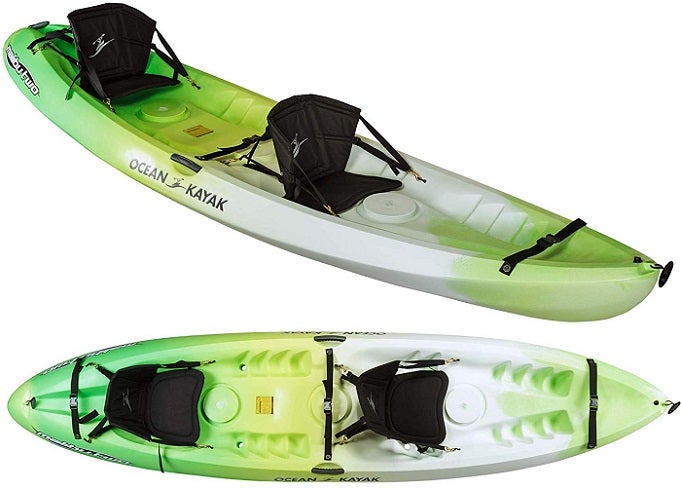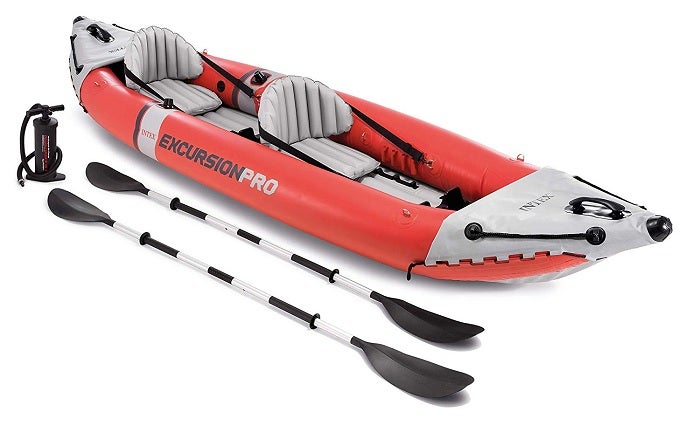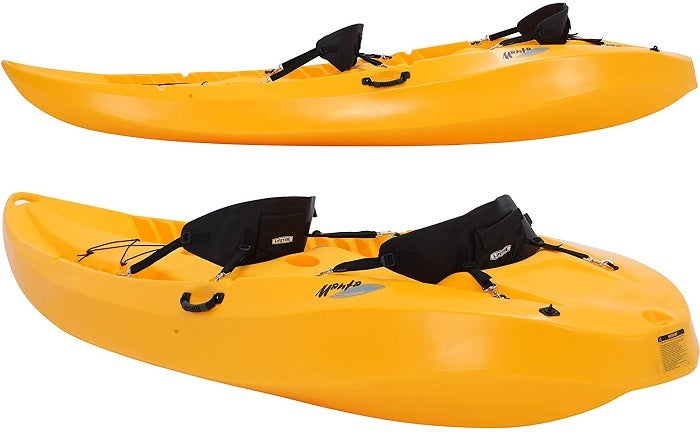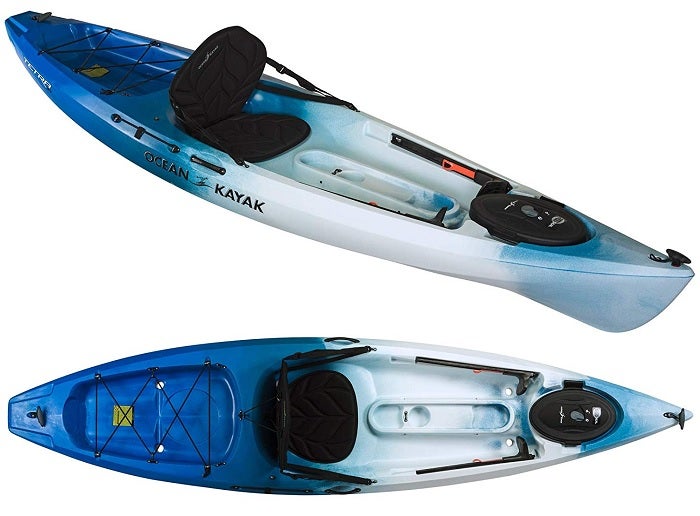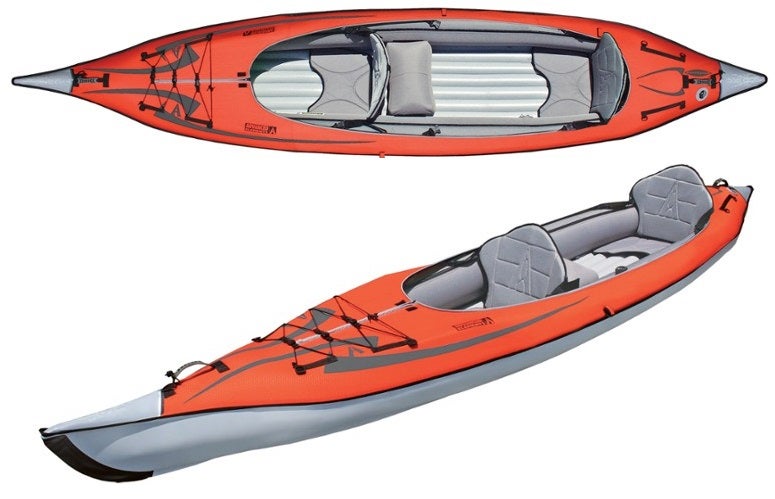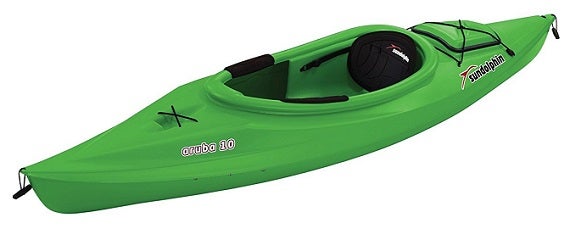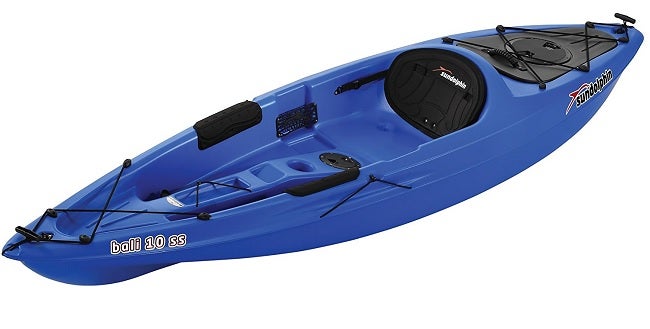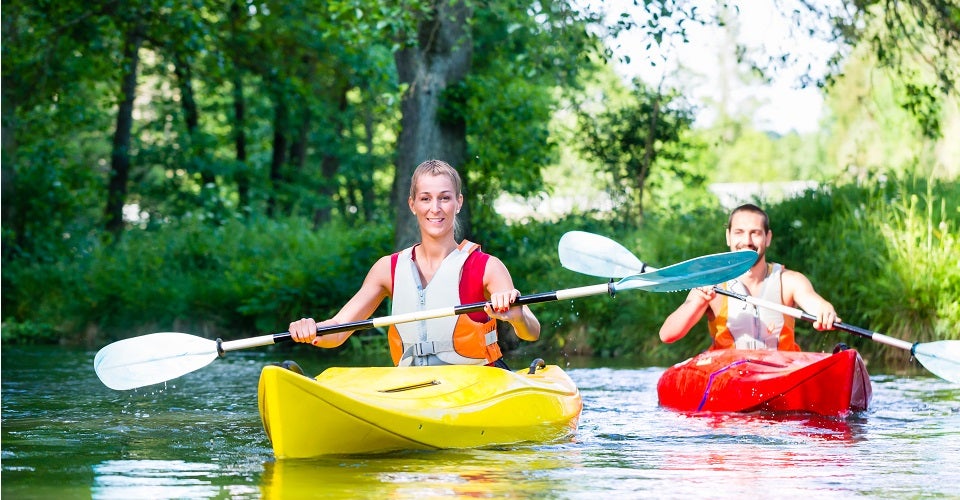
Our Editors independently research, test, and rate what we feel are the best products. We use affiliate links and may receive a small commission on purchases.
There’s no time like summer (or anytime!) for a kayaking trip.
What’s that?
You don’t have a kayak? Well, you’re in luck because we’re going to walk you through everything you need to know in order to pick out your first kayak.
Then we’ll review a few possible choices you have for purchasing a kayak. By the time you’re done, you’ll know what to look for and where to start finding the best recreational kayak for you!
Whether you’re looking for a kayak for you or your family we’ve got it covered.
There are so many kinds of kayaks out there and not every manufacturer makes it clear what activity each kayak is best for. That’s why we’re going to get started with what you need to know right now.
Best Recreational Kayaks
For more of my kayak gear recommendations, have a look through these popular Outside Pursuits guide links: Kayak Roof Racks, Kayak Paddles, Kayak Carts
Quick Answer: The 7 Best Rated Recreational Kayaks
- Ocean Kayak Malibu XL Recreational Tandem Kayak
- Driftsun Voyager 2 Person Tandem Inflatable Kayak
- Lifetime 10 Foot Manta Tandem Kayak
- Ocean Kayak Tetra Recreational Sit-On-Top Kayak
- Advanced Elements AdvancedFrame Convertible Inflatable Kayak
- Sun Dolphin Aruba 10 Sit-in Kayak
- Sun Dolphin Bali SS 10-Foot Sit-on top Kayak
Be safe always wear a kayak PFD. If you are in the market for inflatable kayak, see our reviews here. Now we’re going to show you a lineup of top rated recreational kayaks.
Recreational Kayak Reviews
#1 Ocean Kayak Malibu Recreational Tandem Kayak
- Weight Capacity: 425 Pounds
- Length: 12 Feet
- Bow and stern carry handles
- Padded seat back for comfort
For many reasons sit on top kayaks make some the best choices for recreational kayaks. They’re versatile, easy to use, and self-bailing.
I love the open design of this kayak with tons of space, a generous seat, and two large deck lashings. The large forward are of this kayak give you plenty of storage and also makes it a good design to take your dog with you.
It weighs 57 pounds which is pretty good for an affordable recreational kayak. Ocean Kayak uses what they call a “Tri-Form hull” with the Malibu that gives the kayak exceptional stability plus good tracking and maneuverability.
One feature I like is the replaceable rear skid plate which can be changed out if the kayak becomes worn from use. Not a bad call! The addition of the molded drink holders is a nice touch.
The Ocean Malibu is my top pick for the best recreational kayak. If you are looking for a single Ocean Kayak, take a look at the Ocean Kayak Malibu 10.5.
#2 Intex Excursion Pro Inflatable Kayak
- Weight Capacity: 400 Pounds
- Length: 12.5 Feet
- Made from 3 layer PVC
- Has a bow and stern storage and two rod holders
This is a tandem inflatable recreational kayak designed for paddling on quiet water but can handle some chop. This kayak is perfect for slow rivers, lakes, ponds, and other recreation friendly water.
Being an inflatable kayak you may think it could puncture easily but not so with the Intex. It has a thick PVC tarpaulin bottom to protect it from sharp rocks, sticks etc.
The Intex Excursion has adjustable seats and two removeable skegs to provide good tracking. For an inflatable kayak there is a surprising amount of covered storage in the front and rear.
I like the removable bracket that can be adjusted and mounted with a GPS, fish finder, or a rod holder.
It’s a complete package meaning it comes with two paddles and a pump to inflate the kayak and a carry bag. Intex is known for making quality kayaks and the Excursion is the best recreational kayak under $500.
#3 Lifetime 10 Foot Manta Tandem Kayak
- Can be used for solo and tandem
- Weight capacity: 500 Pounds
- Includes 2 soft backrests and 2 double sided aluminum paddles
- Raised seats keeps you dry and out of the water
With the ability to paddle single or double person (tandem) and a sit on top design, this is the ultimate in versatility.
While the back rests leave something to be desired and the seating is not going to be comfortable for longer trips, it’s a solid choice for the lake house couple. Lifetime also touts the tunnel hull design as “almost impossible to tip over”.
I would say this two person kayak is at its best for short trips with couples that want the flexibility of a sit on top kayak and don’t mind giving up some comfort.
I like the fact that they included paddles, the Manta is one my top picks for the best tandem recreational kayak.
#4 Ocean Kayak Tetra Recreational Sit-On-Top Kayak
- Weight capacity: 275-300 Pounds
- Length: 10.6 Feet
- Tracks well on flat water and ocean swells
- 6″ cam lock hatch for dry storage
This is, of course, a sit on top kayak as the name suggests. That means more leg room and flexibility for paddlers.
It also means that the boat is able to feature an easily accessible gear compartment. Shock cord lashing is all you get for storing gear so make sure it’s already waterproof! There is one in-deck waterproof storage compartment that’s large enough for a day outing.
I like the flexibility and options that sit on top kayaks offer to users. Don’t worry there is an adjustable seatback for the kayak so you won’t have to spend all day sitting upright without back support.
The Ocean Scrambler might be the best recreational sit on top kayak, especially when you consider its price tag.
#5 Advanced Elements Convertible Tandem Inflatable Kayak
- Weight capacity: 550 Pounds
- Length: 15 Feet
- EVA Padded high back seats
- Front & rear storage for gear
The Advanced Elements is our second inflatable kayak and is the longest recreational kayak on our list. This makes it ideal for touring and for all day paddling.
The Advanced Elements is not like any other inflatable kayak you may be familiar with. The bow of the kayak has aluminum reinforcement that greatly aids in rigidity and tracking.
The high seat backs provide all day paddling comfort and has built in paddle holders when you want to take a break or maybe try some fishing.
The AdvancedFrame Convertible has 3 separate air chambers for safety in the unlikely event you have a puncture or leak. The tough PVC construction resists tears and abrasion.
What I really like about this kayak is that you can easily use it as a tandem kayak OR a solo touring mode by moving the seat position.
There is an abundance of storage for a cooler or PFDs, or other gear. Not only that there is bungee storage for easy access and D-Ring tie downs. By far the best recreational kayak for the money!
Note: You will need a pump, here is a link to the Advanced Elements Pump, I would recommend an electric inflatable pump, you can see my reviews here.
#6 Sun Dolphin Aruba 10 Sit-in Kayak
- Weight capacity: 250 Pounds
- Length: 10 Feet
- Stern storage with shock cord deck rigging
- Convenient carrying handles
This short, 10-foot kayak comes in several colors. It features a gear well behind the cockpit with webbing straps for extra gear.
There’s also a built-in water bottle holder or drink holder right in front of the cockpit which is a pretty nice addition for hot days on the river. If your color conscious, there are 5 brilliant colors to choose from.
Made from UV-stabilized polyethylene and featuring a slightly adjustable seat this kayak makes a smart choice for the recreational user.
It also comes in lower on the price scale and my pick for the best cheap recreational kayak. The Sun Dolphin Aruba is also available in a 12 foot model if you are looking for a touring model.
#7 Sun Dolphin Bali SS 10-Foot Sit-on top Kayak
- Weight capacity: 250 Pounds
- Length: 10 Feet
- Large stern storage with shock cord deck rigging
- Comfortable seating area with protective thigh pads
Let me just say that for the price, this kayak is packing a ton of great features! I love the portable accessory carrier system that can be used as backpack, tow-behind, or in boat storage system.
Two dry storage compartments are included along with cock cord and deck rigging for gear. The large open cockpit provides for easy entry and exiting from the kayak.
It’s also a sit on top design which automatically offers some of the best versatility and flexibility of any type of boat. The Bali comes in 6 brilliant colors to choose from, your sure to like one of them!
The Sun Dolphin Bali would be my pick for the best cheap kayak, but just because its cheap doesn’t mean its not a good kayak! The Sun Dolphin Bali SS is available as a 12-Foot model if you are looking for a touring model.
Recreational Kayaks Comparison Table
| Recreational Kayak | Length | Type | Kayak Weight | Kayak Capacity | |
|---|---|---|---|---|---|
| Ocean Kayak Malibu XL Kayak | 13.3 Feet | Sit on Top / Tandem | 61 Pounds | 500 Pounds | |
| Intex Excursion Pro Inflatable Kayak | 12.5 Feet | Inflatable / Tandem | 39 Pounds | 400 Pounds | |
| Lifetime Manta Tandem Kayak | 10 Feet | Sit on Top / Tandem | 60 Pounds | 500 Pounds | |
| Ocean Kayak Tetra Recreational Kayak | 10.5 Feet | Sit on Top / Single | 47 Pounds | 300 Pounds | |
| Advanced Elements Convertible Inflatable Kayak | 15 Feet | Inflatable / Tandem | 52 Pounds | 550 Pounds | |
| Sun Dolphin Aruba | 10 Feet | Sit In / Single | 40 Pounds | 250 Pounds | |
| Sun Dolphin Bali SS | 10 Feet | Sit on Top / Single | 40 Pounds | 250 Pounds |
How to Choose the Best Recreational Kayak
- Recreational Kayaks
- Whitewater Kayaks
- Touring Kayaks & Sea Kayaks
- Sit-on-Top Kayaks
- Sit-in-Kayaks
- Kayak Features
- Kayak Materials
- Pros and Cons of Sit-on-Top Kayaks
- Pros and Cons of Sit-In Kayaks
- Recreational Kayak Comparison
- Best Kayak Brands
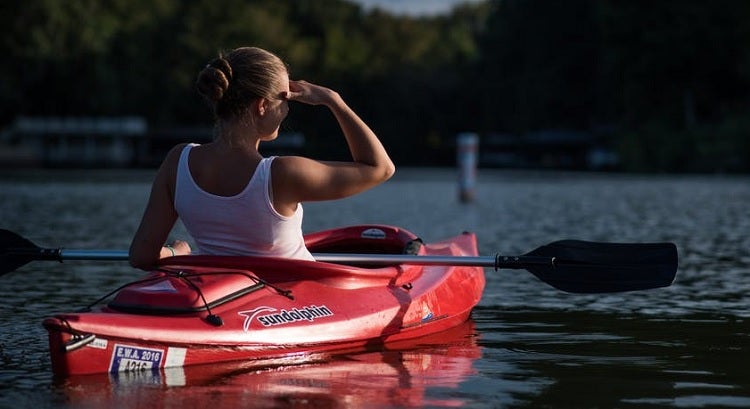
Let’s start by reviewing a few of the types of kayaks available to you. Then we’ll talk about specific features and what you should look for or avoid. When we’re done you’ll have a great idea of where to start looking for the perfect kayak!
First lets answer the question: What is a recreational kayak?
I would define a recreational kayak as a kayak that is used by the occasional/casual paddler that will use it on flat water conditions such as a lake or slow moving river. It will be used primarily for recreation like exploring, exercise and site seeing but not necessarily fishing and definitely not white water rafting.
What Makes a Good Recreational Kayak?
A good recreational kayak will be easy to get into, track well but will not be as good as a longer touring kayak. They are stable and difficult to tip over and maybe most importantly be easy to paddle!
Recreational Kayaks
Recreational kayaks are the plastic ABS kayaks you’ll find at most local liveries. These types of kayaks are designed to be affordable and perform moderately well on most flatwater. While I’ve made these types of kayaks work for camping and fishing trips, I wouldn’t recommend it.
Seek out these kayaks if you’re looking for affordable boats that you can take an occasional weekend family or friends trip with. They’re not usually meant to tackle whitewater, hold gear for long trips, or be outfitted for fishing.
Whitewater Kayaks
Ranging from super short to moderately long these kayaks can span the breadth of shapes and sizes. Many of these boats are made for specific and advanced types of paddling.
They’re usually more expensive and a bit harder to find than a recreational kayak. Go to the nearest whitewater rafting center and inquire if you’re not sure where to begin looking for a whitewater kayak.
Touring Kayaks & Sea Kayaks
These boats tend to be long and narrow with features unique to long paddling on open water. Often, they’ll feature a rudder or skeg to aid in navigation and tracking.
They’ll always have added bulkhead space for storing gear and some will even have watertight compartments. These boats can tend to be the most expensive and niche types of kayaks available.
Put plenty of thought into your choice before choosing a touring kayak for long trips!
Sit-on-Top
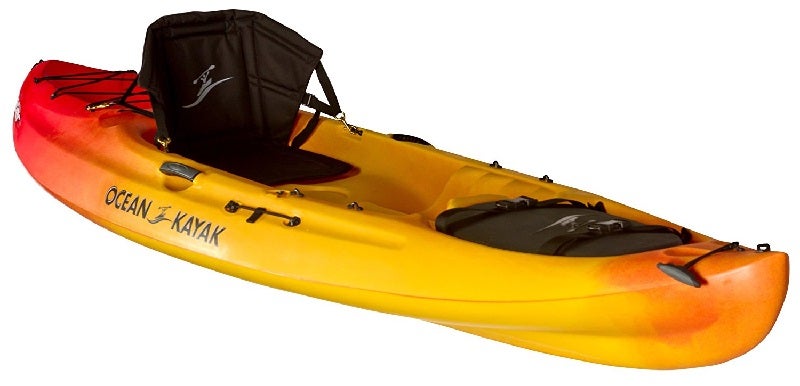
Sit on top kayaks are newer and quite popular for several reasons. They’re self-bailing which means they can’t be filled with water. That makes them easy to use and maintain.
They also allow more leg room and flexibility in paddling. However, they lack much of the performance of many other types of kayaks. These are best for recreational trips or days around the lake cottage.
Sit-in-Kayak
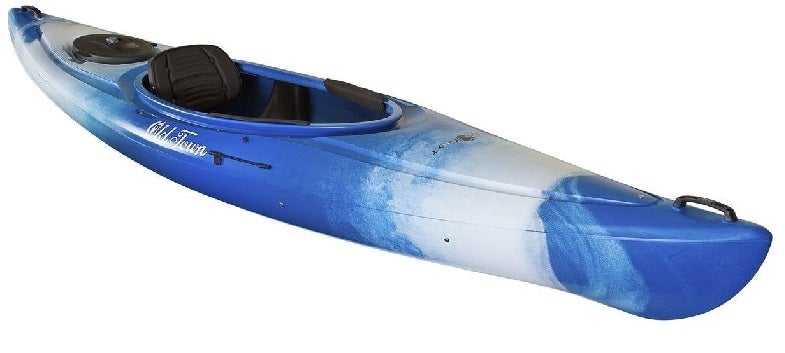 Like a sit in kayak, they have seats, a foot pedal that is adjustable to rest your feet on to get comfortable and provide support to paddle. The biggest difference between a sit in kayak and a sit inside kayak is the fact that the sit in kayak is enclosed.
Like a sit in kayak, they have seats, a foot pedal that is adjustable to rest your feet on to get comfortable and provide support to paddle. The biggest difference between a sit in kayak and a sit inside kayak is the fact that the sit in kayak is enclosed.
This gives you protection from the elements that you do not get from a sit in kayak. This is called the “cockpit”. If you will be out in bad weather, you can attach a “spray skirt” that will keep water out and block some of the wind.
They quite different styles of kayaks and the easiest way to decide to to figure out how you will use the kayak and that will tell you what’s the best kayak for you.
Which is Better for You: Sit-in-Kayak or Sit-on-Kayak?
By answering these questions, you will have a better idea of which type is better for you.
- Will you be paddling in warm weather and water conditions? If you will be using the kayak in cold water/weather conditions, a site in kayak may be best for you.
- Are you a beginner and worried about the kayak tipping over? A sit in kayak is more stable due to the fact you are sitting lower in the kayak and will have a lower center of gravity providing more stability.
- Will you be kayaking in calm/sheltered water or in the ocean? A sit in kayak will keep you more protected from the elements and the ability attach a spray skirt giving you more protection from the elements that a sit in kayak.
Kayak Features
- Spray Skirt – this addition is common among whitewater and touring boats. It prevents waves and water from entering the cockpit and submerging the boat.
- Rocker – One of several design considerations in a kayak’s shape. Rocker describes the amount of arc or “banana” shape that the boat has. The more rocker, the easier to turn.
- Skeg – This often detachable or retractable fin helps to stabilize some kayaks in windy conditions or when paddling straight over long distances.
- Rudder – Not to be confused with a skeg, the rudder is actually use in controlling the direction of the boat as an aid to paddling.
Kayak Materials
Polyethylene – The most common and least expensive material to produce boats from. It’s cheap but heavy. Poly tends to break down with exposure to UV so store boats in the shade!
ABS – More resistant to sunlight damage than Poly boats. ABS is more expensive but more durable and easier to repair.
Composite – These can be Kevlar, fiberglass, or carbon fiber and they’ll cost you a fortune! These kayaks are lightweight and top-performers across all classes but they’re hard to find and very expensive.
Sit-in-Kayak vs Sit-on-Kayak
Pros and Cons of Sit-on-Top Kayaks
Pros:
- A sit on top kayak is more beginner friendly, they are easier to get into and out of. If you are at all claustrophobic, then the enclosed feeling of a sit in kayak may make you uncomfortable.
- A sit in kayak will be self-bailing because they have what are called “scupper holes”. These are holes that allow water splashed into the kayak to drain out.
Cons:
- This type of kayak is best for warm weather/water conditions.
- You are much more likely to get wet from waves splashing and water dripping off the paddles.
Pros and Cons of Sit-In Kayaks
Pros:
- A sit in kayak will shelter the lower part of your body from the wind making it a warmer paddling experience.
- You will have a lower profile, making it slightly easier to paddle because there is less wind resistance. It also gives you a lower center of gravity making it more stable than a sit on top kayak.
Cons:
- A sit in kayak is more difficult to get in and out, so if you are less flexible, this may not be the best type of kayak for you.
- They are not self-bailing, if water splashes in the kayak you will need to flip it over to drain it.
Kayaking Safety Tips
We’ve listed some of the top kayaking safety tips below. If you are an experienced kayaker, we’d love to hear from you in the comments below about your top safety tips!
Tip #1: Know Your Capabilities
Especially when you first start out, you may not be able to handle the rougher waters of rapids or the ocean. Knowing your capabilities will help keep you from getting into a situation that’s hard for you to handle. It’s always best to start out with calm, short trips. If you are attempting a more difficult trip, be sure to bring someone with you who has the skills necessary.
Tip #2: Research Weather Conditions Before You Set Out
Weather can play a large part in the safety of your trip. Be sure to check the weather forecast several days before you plan on heading out. Check again before leaving just to make sure. Many places, such as national parks, also report their own weather forecasts. This makes it easy to see the current weather conditions in the exact place you plan on kayaking.
Tip #3: Pack and Recheck Safety Gear
When packing for your trip, be sure to make a list of all safety gear you will need. Make a checklist of all your safety gear and double check before you leave. Having the proper safety gear with you, even on short trips, is vital.
You should always have a first aid kit in a waterproof case, a cell phone that is sealed in a waterproof bag, and other things needed for the area you will be in. For example, you may need fire starting sticks, a poncho, and even nutrition such as granola bars and bottled water. What do you plan on bringing on your next trip? Leave us a comment below!
Tip #4: Plan for Immersion
When kayaking, it’s always best to plan for immersion. Immersion means ending up in the water, also known as capsizing. If the water is a little chilly, be sure to wear a wetsuit and always wear a life jacket. You should also be comfortable with the kayaking techniques necessary to right yourself. Immersion can often be one of the most fun aspects of kayaking. However, it can be a scary experience if you’re not prepared.
Tip #5: Use the Buddy System
As with many outdoor sports, it’s important not to go it alone. Having an experienced friend with you on your trip will ensure you have the help if needed, and you’re there to help them as well. With two or more kayakers you will of course need a tandem kayak and it also allows you to bring more supplies. Especially if using a kayak seat with storage. In the event of an emergency, using the buddy system is vital. Be sure they have the right kayak seat too!
FAQs About Recreational Kayaks
Q: Are sit on top kayaks more stable?
A: No, a sit inside kayak is going to be more stable because you are sitting lower in the kayak and as a result has a lower center of gravity than a comparable sit on top kayak.
Q: What size recreational kayak do I need?
A: This depends on several factors. How much storage so you need? Longer kayaks of course give you more storage options. Shorter kayaks are easier to maneuver but hard to keep in a strait line. Generally a 10ft kayak is long enough for most paddlers.
Q: Do kayaks tip easily?
A: Beginner and recreational kayaks are designed to be very stable. While a kayak may seem easy to tip over they are not. The flat bottom on most beginner kayaks makes them very stable and difficult to flip.
Q: Is a longer or shorter kayak better?
A: Neither is better, they have different characteristics though. As a general rule shorter kayaks are easier to turn and maneuver than a longer kayak however a longer kayak is easier to paddle and keep in a straight line.
Q: Which is better a sit on top or sit inside kayak?
A: Personally? Well… I think it really depends on what I’m doing.
Sit on top kayaks are awesome for getting in and out easily. They also rock as fishing kayaks thanks to the extra arm and leg room plus several key fishing accessory possibilities.
However, if I’m going to on a longer trip I probably want to have a traditional “sit inside” type kayak. They tend to be a little more efficient over longer distances. You can find a lot more refined types of traditional kayaks such as sea kayaks, racing kayaks, and whitewater kayaks.
Unless you need a specific type of kayak it’s probably best to just go with a sit on top model. They’re easier to use and more versatile for general recreational use, especially if you’re only going out once in a while.
Video: How to get into and launch a sit-inside kayak.
Video: How to launch a sit-on-top kayak.
Best Brands of Kayaks
 There are quite a few manufactures of kayaks these days but there are a few that stand out because of superior quality and customer service. Many of these manufactures have been around for decades so you can count on them being there in the future!
There are quite a few manufactures of kayaks these days but there are a few that stand out because of superior quality and customer service. Many of these manufactures have been around for decades so you can count on them being there in the future!
Ocean Kayak – Ocean has been around for decades and one of the oldest makers of kayaks. They have a wide variety of offerings that range from beginner kayaks to advanced touring kayaks.
Old Town Canoes & Kayaks – Is now owned by Ocean Kayaks they have kept the name however. Being a part of Ocean I think we can be assured the quality will still be there. They have a wide range of kayaks and canoes on offer.
Sun Dolphin – Manufactures Sun Dolphin kayaks and canoes for the recreational paddlers. They offer a wide variety of kayaks and other watercraft like SUPs and dinghies.
Lifetime – Manufactures a wide variety of outdoor recreational equipment. They make everything from basketball equipment to recreational kayaks and SUPs.
How We Researched
To come up with the top recreational kayaks we researched a variety of sources for reviews such as REI, Dicks Sporting Goods, Cabelas and Backcountry along with our own personal experience.
We also consulted online magazines for product research and reviews to get as much unbiased information as we could. To help weed out fake reviews we used Fakespot.com to make sure we only looked at genuine reviews.
With so much quality gear available, we had to narrow it down based on what we felt were the best options for the price. The author, Casey Fiedler has been an avid kayaker and leads kayak camping trips during the summer months in his native state of Michigan.
To help narrow down the selection he used his personal experience along with recommendations from kayak tour guides and rental shops.
After extensive research, we came up with our list to help you choose the right one for you.
Sources
I hope this guide was helpful for finding a good recreational kayak to fit your needs. If you want to comment or recommend a kayak I didn’t include, please use my contact form to get in touch.
Have fun and be safe out there!

